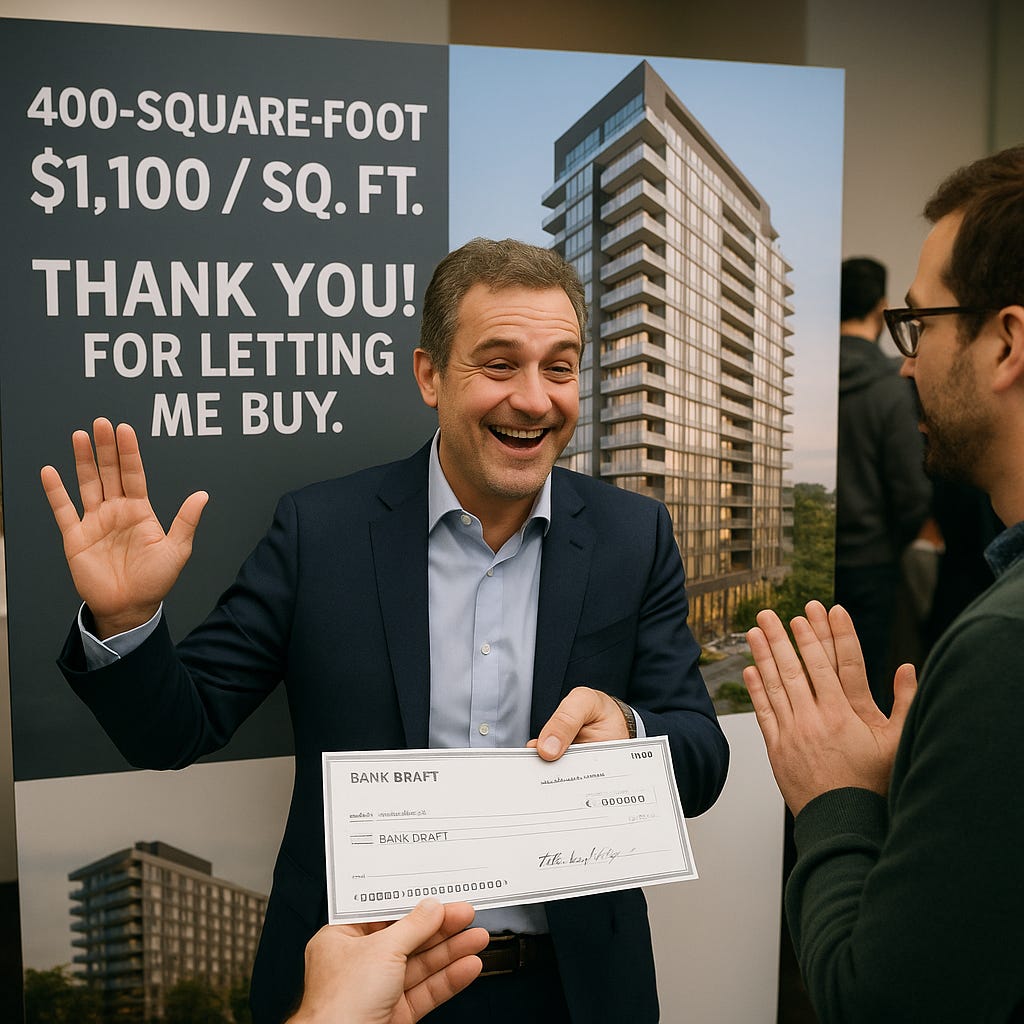I remember standing in the presentation centre of a midtown project back in 2017, watching investors line up like it was a new iPhone launch. We hadn’t even opened the doors yet and someone was already waving a bank draft like they were trying to get an advance copy of GTA6.
We were selling 400-square-foot one-bedders at $1,100 a foot, and people were thanking us. “Thanking us!” For letting them buy.
At the time, I remember thinking, this feels a little too easy. But hey—when it’s raining money, you don’t ask why the clouds are full.
Well, it’s not raining anymore.
Now we’re all standing in the same rooms with empty models, unanswered phones, and “future phases” that may never see the light of day.
💀 The Condo Market Has Flatlined
This isn't a cyclical cold. It's a systemic shutdown.
Any high-rise project that planned to chop its building into micro-units for investors is going to be on ice indefinitely. The math is broken. The buyers are gone. The dream of endless appreciation is dead—or at least in a coma.
Let’s be clear: the pain hasn’t even really started yet. The blood is just beginning to trickle into the streets. What’s coming is much worse.
🚧 The Pipeline Is a Bomb with a Delayed Fuse
We’ve got tens of thousands of sold-but-not-yet-completed units currently under construction—locked into outdated pro formas with totally unrealistic expectations:
Presale prices: $1,500–$1,800 per square foot
Cap rates: Under 2%
Hard costs: Now showing at $300–$400/SF (and that’s if you believe in miracles)
These deals were built on assumptions that simply don’t apply anymore. But the buildings? They’re still rising.
What happens when those buyers are asked to close in 2025–2026?
🔥 Incoming: Appraisal Carnage
Appraisals will come in light.
Buyers will try to walk.
Lawyers will get rich.
Assignments will stack up, slashed, and desperate.
The backlog will be brutal—and it’s already baked into the next 12–24 months. These aren’t hypotheticals. They’re construction cranes in the sky today.
🧊 Why We're Not Feeling the Pain—Yet
We haven’t seen the true impact because:
Closings are still a year or two away.
Developers are holding inventory off-market.
Projects that can’t work are getting shelved before they embarrass themselves.
But this pain is deferred, not avoided.
🧠 Reality Check: What Would It Take to Revive the Market?
1. Interest Rates Would Need to Drop—Hard
We’d need the Bank of Canada to cut by 100–175 basis points—bringing the policy rate from the current 2.75% down to 1%–1.75%—to restore investor confidence and make cash flows remotely viable on typical precon condo deals.
🧾 Rate Reality Check Sidebar
Is 1%–1.75% realistic? Only if we enter a sharp recession.
BoC’s pre-COVID “normal” was 1.75%.
Most likely? We bottom out around 2%, and that’s if inflation stays tame.
Bottom line: If your model needs a 1% rate to work, your project might already be a corpse.
2. Prices Fall, Rents Rise, or Wages Catch Up (Pick One)
The current pricing makes no sense:
Rents don’t justify carrying costs.
Sale prices don’t justify construction costs.
Monthly payments don’t align with average incomes.
So either:
Sale prices drop 15–20%, or
Rents rise another 25–30%, or
Wages go up 30–40% across the board, which isn’t happening anytime soon, or
Costs drop (spoiler: they won’t).
3. We Need to Build Homes, Not Investments
The market has spoken. People don’t want 390 SF bachelor boxes. They want:
800+ SF for a 2-bed
Real storage
Livable layouts
Balconies you can stand on without touching both railings
The trouble? Most of the pipeline can’t pivot. The layouts are locked. The numbers break if you reduce the unit count. There’s no undo button on these deals.
🏗️ The Shelf of Doom
There are countless projects already zoned, approved, and shelved—waiting for “the right time” to launch.
Here’s the real kicker: many of these projects were never meant to be built.
They were purchased with one intention—zone and flip.
That play worked when capital was cheap and land prices only went up. But today? There are virtually no buyers for zoned sites. The music stopped, and now everyone’s stuck holding entitlement packages nobody wants.
As more projects receive approvals and join the shelf, the backlog grows deeper and heavier.
When the market does show signs of life? Every developer hits the launch button at once. And what happens when too much inventory floods a fragile recovery?
The rebound collapses under its own weight.
🔮 So What Does the Next 3–5 Years Look Like?
Selective Launches
Only the best projects, in prime locations with true end-user demand, go forward.Rental Conversions
Developers who can afford to pivot will, especially with CMHC’s support. Most won't.Distress Quietly Spreads
Expect:Silent GP buyouts
Discounted land deals
Lenders stepping in (quietly, at first)
Product Reinvention
Success belongs to those who:Design for end users
Focus on functionality
Know how to survive a slow burn, not a sprint
🧱 Final Word from a Guy Who’s Been Through It Before
The investor-fueled condo boom is over. The next cycle will be slower, smarter, and less speculative.
If you're a developer: You need to rethink your product, your capital stack, and your timeline. If you’re not already doing that, you’re already behind.
The patient isn’t dead. But we’re going to need more than a rate cut to revive it.
We’re going to need a full-blown transplant.










Great article! Truth this clearly stated is not found in the msm (that's for sure).
FINALLY!!! A realistic actually foreseeable outlook. Now of course we will see a HUGE amount of propaganda devoted to changing this all too foreseeable outlook. We will see calls for reduced DC's - reduced interest rates - subsidies - massive population growth - reduced safety and building requirements ie stairways fenestration - DENSITY. What you fail to say, is that the DENSIFICATION nightmare you are flaunting will directly irrevocably and unquestioningly exacerbate the urban nightmares we are already experiencing - while costing an unaffordable fortune in dysfunctional upgrading. The Laurentians applaud - but the folks you whose lives are eroded will rebel. This vast land has plenty of room to build desirable SFD - the housing preferred by the vast majority.